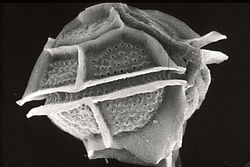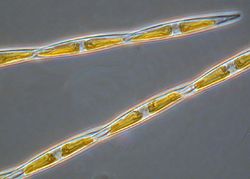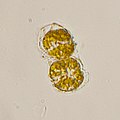A harmful algal bloom (HAB), or excessive algae growth, sometimes called a red tide in marine environments, is an algal bloom that causes negative impacts...
166 KB (18,619 words) - 02:36, 26 May 2025
algae. An algal bloom affects the whole ecosystem. Consequences range from benign effects, such as feeding of higher trophic levels, to more harmful effects...
40 KB (4,723 words) - 18:51, 28 May 2025
Dinoflagellate (section Harmful algal blooms)
visible coloration of the water, colloquially known as red tide (a harmful algal bloom), which can cause shellfish poisoning if humans eat contaminated...
103 KB (11,050 words) - 23:21, 22 May 2025
Eutrophication (section Algae bloom forecasting)
being introduced. Some harmful algal blooms resulting from eutrophication, are toxic to plants and animals. Freshwater algal blooms can pose a threat to...
85 KB (9,035 words) - 12:07, 27 May 2025
Lough Neagh (section Algal bloom crises)
health from toxins and pathogens detected in the algal mats found in the lake. These harmful algal blooms have a number factors contributing to their occurrence...
38 KB (4,016 words) - 17:52, 22 May 2025
Cyanotoxin (redirect from Cyanobacterial bloom)
a few days, but blooms can last weeks. While some of these blooms are harmless, others fall into the category of harmful algal blooms, or HABs. HABs can...
47 KB (5,138 words) - 15:18, 5 February 2025
Sea foam (section Harmful algal blooms)
and lipids) derived from sources such as the offshore breakdown of algal blooms. These compounds can act as surfactants or foaming agents. As the seawater...
29 KB (3,209 words) - 02:57, 30 December 2024
surface as sedimentary rocks. The rapid formation of algal mats can result in harmful algal blooms (HABs), also known as red tides or green tides. HABs...
10 KB (1,312 words) - 03:54, 18 May 2024
The Harmful Algal Bloom and Hypoxia Research and Control Amendments Act of 2014 (S. 1254; Pub. L. 113–121 (text) (PDF)) is a U.S. public law that reauthorizes...
16 KB (1,662 words) - 16:33, 29 May 2025
Clear Lake (California) (section Harmful algal blooms)
lake can produce blooms often beginning in the spring and lasting through the fall. Referred to as harmful algal blooms (HAB), these blooms consist of solid...
55 KB (5,948 words) - 22:19, 5 May 2025
more phosphorus into the lake, enabling harmful algal bloom. Along with this algal bloom in 2016, other algal blooms have been found to occur in relation...
51 KB (6,055 words) - 23:10, 29 May 2025
cyanobacteria that includes the harmful algal bloom-forming Microcystis aeruginosa. Over the last few decades, cyanobacterial blooms caused by eutrophication...
16 KB (1,610 words) - 15:26, 25 May 2025
Pyrodinium (section Harmful algal blooms)
bahamense variety was nontoxic and found in the Atlantic, but a 1972 toxic algal bloom of Pyrodinium bahamense in Papua New Guinea showed this was not the case...
9 KB (1,109 words) - 01:09, 16 May 2025
higher and peak biomass occurred later in the spring.[citation needed] Algal bloom Critical depth Gordon Arthur Riley Plankton Mann, K.H., Lazier, J.R.N...
18 KB (2,227 words) - 02:01, 26 May 2025
activities and the red tide outbreak. Evidence from Comau Fiord where a Harmful Algal Bloom caused a mass die of cold water coral reefs was directly linked to...
9 KB (951 words) - 09:09, 28 May 2025
Microcystin (section Lake Erie blooms)
detected unsafe levels of microcystin in its water supply due to harmful algal blooms in Lake Erie, the shallowest of the Great Lakes. The city issued...
29 KB (3,000 words) - 09:15, 30 May 2025
nutrient pollution and feed the algae. This leads to eutrophication and harmful algal bloom. Many countries have banned the use of phosphates in detergent, including...
17 KB (1,791 words) - 21:47, 10 April 2025
cyanobacteria that can form harmful algal blooms of economic and ecological importance. They are the most common toxic cyanobacterial bloom in eutrophic fresh...
18 KB (1,862 words) - 19:20, 22 May 2025
distinguishes it from a red tide, which is an algal bloom whose toxins lead to harmful effects in people. Although no harmful effects are known, it is recommended...
5 KB (668 words) - 16:34, 17 August 2024
frequent harmful algal blooms. Also, during droughts, surface waters are even more susceptible to harmful algal blooms and microorganisms. Algal blooms increase...
106 KB (11,956 words) - 18:12, 30 May 2025
Utah Lake (section Harmful algal blooms in Utah Lake)
the Clean Water Act. In recent years, the lake has been prone to harmful algal blooms or HABs. Utah Lake is managed cooperatively by the Utah Division...
64 KB (7,659 words) - 11:39, 24 May 2025
of California for a federal disaster declaration Effects of this harmful algal bloom on wildlife included mortality and seizures of a wide variety of...
19 KB (2,397 words) - 19:07, 20 May 2025
needed] Most shellfish can store saxitoxin for several weeks after a harmful algal bloom passes, but some, such as butter clams, can store the toxin for up...
14 KB (1,422 words) - 00:33, 24 May 2025
Pseudo-nitzschia (section Harmful bloom dynamics)
due to increased awareness of harmful algal blooms (HABs) and their implications for human and ecosystem health. Blooms have since been characterized...
40 KB (4,353 words) - 14:11, 25 May 2025
Marine viruses (section Limiting algal blooms)
Viruses are the main agents responsible for the rapid destruction of harmful algal blooms which often kill other marine life. The number of viruses in the...
91 KB (9,422 words) - 21:04, 22 May 2025
alga that episodically forms toxic surface aggregations known as harmful algal bloom. The species name akashiwo is from the Japanese for "red tide". Synonyms...
14 KB (1,437 words) - 09:27, 6 August 2024
tradeoffs resulting from pH imbalances. Although the drivers of harmful algal blooms (HABs) are poorly understood, they appear to have increased in range...
75 KB (13,633 words) - 20:25, 23 April 2025
human consumption. Because of this, A. catenella is categorized as a harmful algal bloom (HAB) species. While in some areas the causes of HABs appears to...
7 KB (809 words) - 12:45, 3 September 2024
plankton and are present in oceanic waters. They are well-known from harmful algal blooms that cause high mortality of fish. Additionally, they compose a rich...
16 KB (1,165 words) - 10:12, 5 December 2024

























